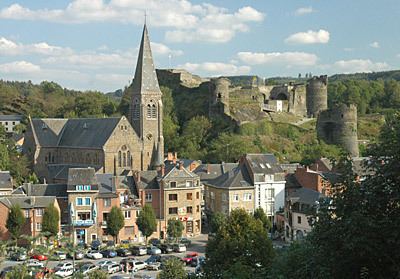Country Belgium Area codes 084 Postal code 6900 | Postal codes 6900 Website www.marche.be Local time Tuesday 3:03 AM Area code 084 | |
 | ||
Weather 8°C, Wind SW at 21 km/h, 90% Humidity Governing parties Centre démocrate humaniste, Mouvement Réformateur | ||
Marche-en-Famenne (Walloon: Måtche-el-Fåmene) is a Walloon municipality located in the Belgian province of Luxembourg. It is the unofficial capital of the Famenne region, sandwiched between the Condroz, former land of the Condrusi, to the north and the Ardennes to the south.
Contents
- Map of Marche en Famenne Belgium
- Middle Ages
- After 1500
- Sights
- Festivities
- Notable people from Marche en Famenne
- References
Map of Marche-en-Famenne, Belgium
The Marche-en-Famenne municipality includes the former municipalities (sections) of Aye, Grimbiémont, Hargimont, Hollogne, Humain, Lignières, Marloie, On, Roy, Verdenne, and Waha.
Middle Ages
In the early Middle Ages, Marche was just a little hamlet on the Marchette brook, one of the dependencies of the nearby Abbey of Stavelot. In the 12th century, this territory was made part of the County of La Roche. It was ideally located, on the main road between Namur and Luxembourg, and quickly evolved into a town, which obtained its charter in the 13th century. At the end of the century, in true medieval fashion, it acquired a complete system of defensive walls, with two gates, a series of watchtowers, and a keep. The market place and religious organizations, such as the Carmes convent founded in 1473, could thrive inside the closed city.
After 1500
When in 1555 Philip II of Spain, son of Charles V, inherited his father’s empire, the freedoms of Spain’s Seventeen Provinces to the north were reduced considerably, giving rise to the Eighty Years' War. In the aftermath of the Pacification of Ghent, Don John of Austria, Philip II’s half brother, granted the Perpetual Edict, which was signed in the city in February 1577. The edict allowed for the departure of the Spanish troops and recognized most of the city’s freedoms, with the notable exception of religion. The war started again and Don John died a year later near Namur.
The castle and defensive walls were dismantled at the end of the 17th century on the orders of Louis XIV. A century later, the French Revolutionary troops entered the city and closed the convent. Today, with its schools, light industries, military complex, and tourist attractions, Marche is a vibrant regional centre.
